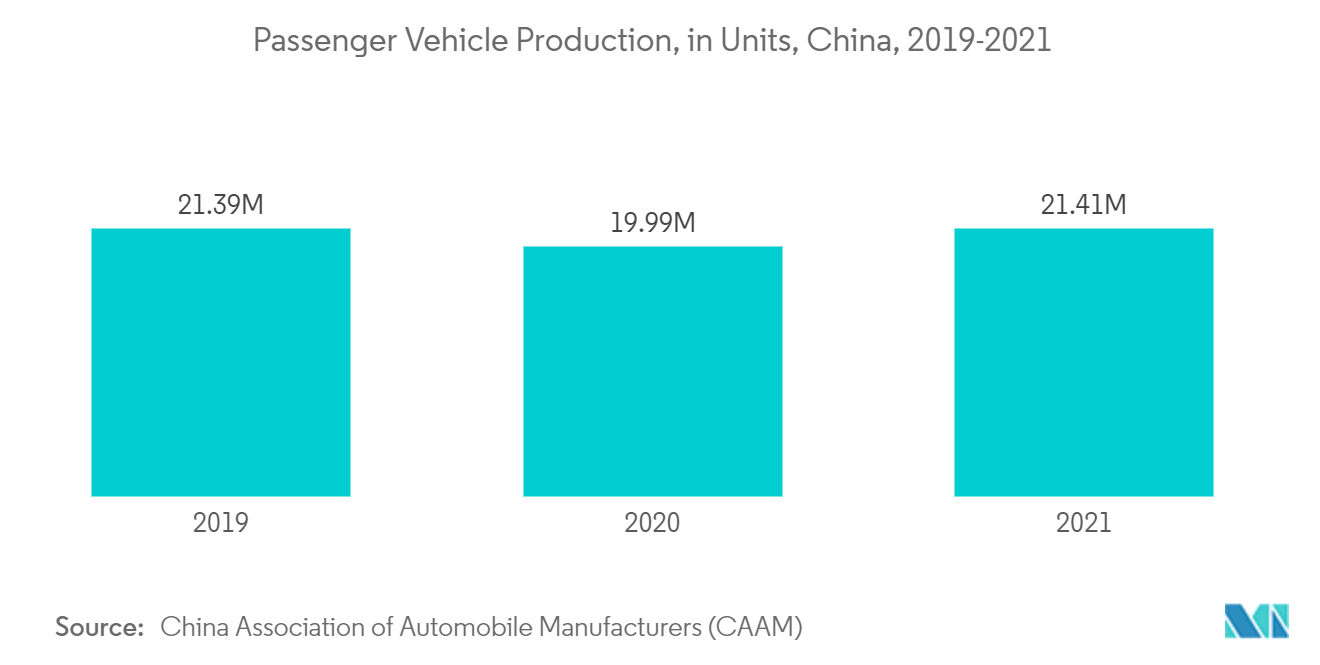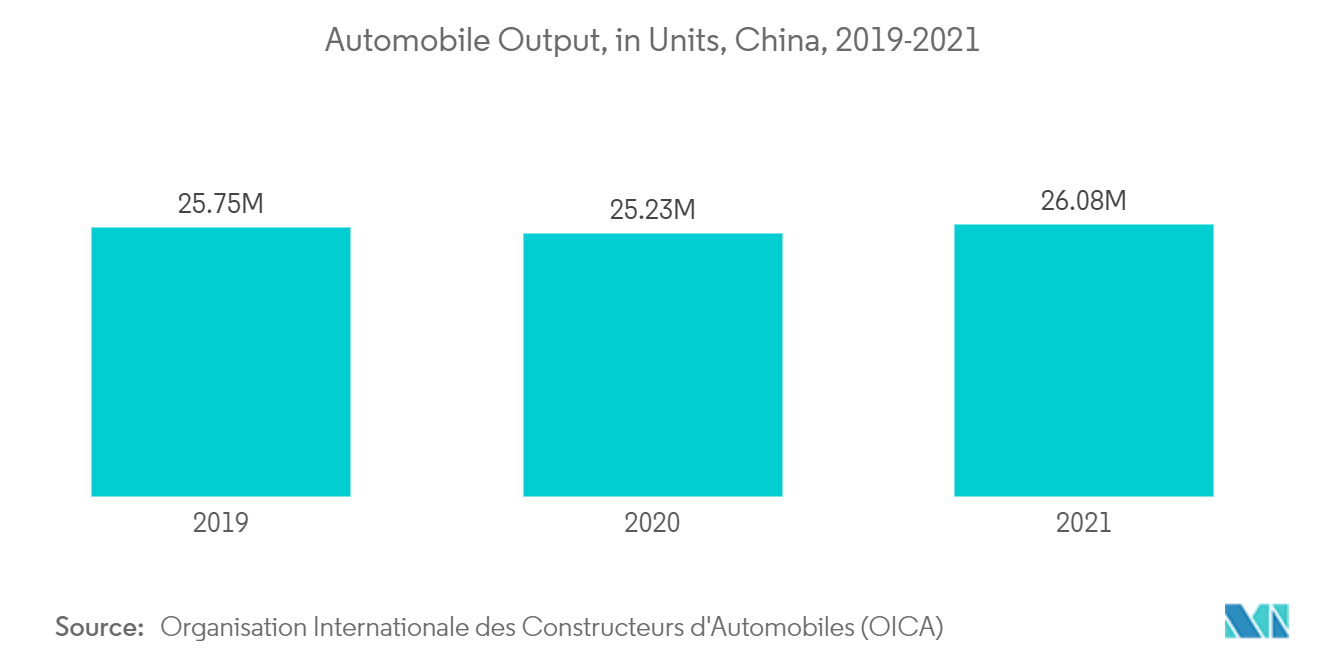Market Trends of Asia-Pacific Bio-ethanol Industry
This section covers the major market trends shaping the Asia Pacific Bio-ethanol Market according to our research experts:
Automotive and Transportation Segment to Dominate the Market
- The automotive and transportation industries are significant bio-ethanol users, which is utilized as a fuel blending ingredient. Bio-ethanol is a cost-effective and ecologically friendly alternative to petroleum and gasoline-powered road vehicles.
- Bio-ethanol has a high-octane number, a high heat of vaporization, and a similar energy content to gasoline. Because of these qualities, it can replace lead as an octane booster. Bio-ethanol's enhanced oxygenation in mixing fuels improves efficient combustion, lowering polluting emissions.
- Bio-ethanol is also utilized as a raw material in the production of ETBE (ethyl-tertiary-butyl-ether), a well-known octane enhancer used in conjunction with gasoline. The amount of bio-ethanol blended with conventional fuels enhances their renewability, which is proportional to the blending percentage.
- The benefits of bio-ethanol blended fuels have also lured the aircraft industry, which is eager to embrace the low-carbon to reduce the massive amount of GHG emissions in the environment. Bio-ethanol has enormous potential for use as aircraft fuel. A large amount of research is being directed toward the development of low-cost, engine-compatible bio-ethanol for jet fuel applications.
- The Chinese automobile industry has been a significant driving factor in China's economic momentum, and despite slowing growth, it is likely to continue fuelling the economy. According to the China Association of Automobile Manufacturers (CAAM), in 2021, China was the world's biggest automobile producer, producing around 21.48 million passenger vehicles and accounting for 29.7 percent of worldwide vehicle production.
- According to the Organisation Internationale des Constructeurs d'Automobiles (OICA), the number of passenger cars produced in India was 6.61million approximately in 2021.
- According to the study, growing the overall ethanol-to-blending rate from 6% to 20% by 2030 may be accomplished if ethanol is created from sugarcane juice. According to the National Institution for Transforming India (NITI Aayog), to attain the 20% objective, India's ethanol output needs to grow to 10.2 billion liters, including 5.5 billion liters from sugarcane and 4.7 billion liters from grains. India had achieved ethanol blending of up to 9.45% by 2021-22.
- According to the Ministry of Economy, Trade, and Industry (METI) and the Japan Automobile Manufacturers Association (JAMA), Japan manufactured roughly 7.85 million motor cars in 2021, down from approximately 8.07 million units the previous year. Japan's motor vehicle manufacturing volume includes passenger cars, lorries, and buses, with passenger cars accounting for the bulk.
- All the above factors are expected to drive the automotive and transportation segment, enhancing the demand for bio-ethanol during the forecast period.

China is Anticipated to Hold a Major Share of the Asia-Pacific
- China holds a prominent share of the Asia-Pacific bio-ethanol market in terms of market share and market revenue. The region is set to continue to flourish in its dominance over the forecast period.
- According to China's bioethanol promotion policy, by 2030, the nation hopes to boost net imports to 26 million metric tons. Meanwhile, due to the country's bioethanol promotion program, China's maize self-sufficiency ratio will fall to 92% in 2030. Furthermore, it has the potential to raise the global maize price index by 5% and the global bioethanol price index by 4% by 2030.
- Until recently, China was a net ethanol importer. The majority of the ethanol came from the United States. However, as a result of the trade war between China and the United States, the Chinese government has imposed tariffs on United States ethanol imports, prompting the US to withdraw from overall commerce in China.
- However, due to the growing cost of crude oil and China's greater reliance on the sector, many provinces in China, especially in the south, imported "approximately 200 million gallons" of US ethanol in the first half of 2021, matching the country's previous record for yearly ethanol imports.
- China is the world's largest vehicle producer. Owing to increased environmental concerns, the country's automobile sector has been preparing for product evolution, with the country focused on creating cars that assure fuel efficiency while limiting emissions. According to the Organisation Internationale des Constructeurs d'Automobiles (OICA), in 2021, the country's automobile output reached 26.08 million, a 3% increase over the 25.23 million vehicles produced in 2020. The increased production of automobiles is expected to raise the demand for bio-ethanol.
- Bio-ethanol is utilized in the healthcare industry to improve applications in medicine such as cancer treatments, illness diagnostic tools, tissue engineering, implants, DNA sequencing, biomarkers, genetic material transfer, and the integrated area of biomedical imaging and neurology. Furthermore, bio-ethanol is employed in a wide range of biomedical applications, including drug/gene delivery, biological sensing and imaging, antimicrobial polymers, and biocompatible scaffolds for cell culture.
- China has the world's second-largest healthcare market. The country does, however, import highly advanced implants from industrialized economies. The country's public hospitals are the country's largest buyers of medical devices.
- China holds a considerable market share in the global medical device industry. According to the State Administration for Market Regulation (China), there were about 27,496 medical device businesses operating in the nation as of the first half of 2021, up from 26,465 in 2020. Mindray Medical, Intco Medical, Lepu Medical, Zhejiang Orient Gene, Shinva, and others are among the leading medical equipment companies.
- Thus, all the above-mentioned factors are likely to provide the increasing demand for the Asia-Pacific bio-ethanol market during the forecast period.

